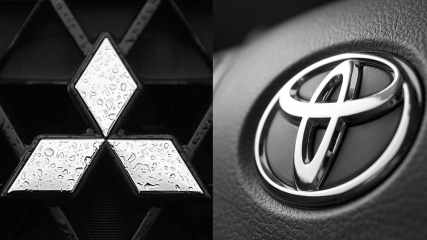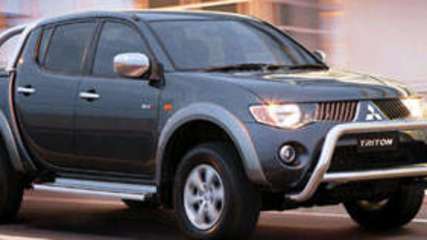Mitsubishi Triton 2006 News

800,000 cars recalled in two days
Read the article
By Joshua Dowling · 30 Jun 2016
Cars are either being built worse -- or companies are getting better at detecting faults.a range of models made over the last 10 years replacing potentially deadly Takata airbags in 1.3 million cars in Australia. a second, airbag-related recall for the Priusreplacing potentially deadly Takata airbags in 1.3 million cars in Australia

Mitsubishi Triton is 4WDOTY
Read the article
By Fraser Stronach · 25 Jan 2010
Mitsubishi's Triton took the prize because of its then newly introduced 'Super Select' 4WD system, effectively a full-time 4WD system that gives the driver the option of using high-range 2WD.The new ML model, at least in GLX-R spec as tested here, carries over this 'category-busting' feature but what is more significant is the availability of electronic stability and traction control, and side and curtain airbags on all Triton 4WD dual cabs. This is another category buster and the GLX-R gets both as standard.Set-piece hill climb/test track
Despite all their technical advantages, the Triton comes close to matching the two Prados on the most difficult of the set-piece climbs. Like the Prados it hangs up on its rear diff housing, but a little earlier than they do.Trail Drive
The GLX-R (and the lower spec GL-R, but not the GLX) has what Mitsubishi calls Sports suspension. The result is a more comfortable ride than what you except for a ute on rough and rocky trails. It's not Prado comfortable but it's good.Touring
With the benefit of full-time 4WD and stability control, the Triton tackles loose gravel roads with far more confidence than normal for this class of vehicle. The only glitch here is that the steering is little vague and a tad on the slow side, and the front suspension feels too underdamped at higher speeds. The Triton is okay in the very soft sand of our test venue but needs low range and the stability control cancelled to give its best.Inside
The Triton has side and curtain airbags as well as the usual driver and passenger airbags. Add in three lap/sash belts and three headrests for rear seat passengers and you have the pinnacle of dual-cab safety. Summary
The Triton wins this contest on the grounds that anyone who wishes to purchase a dual-cab ute rather than a 4WD wagon for wide-spectrum use including recreational four-wheel driving no longer has to compromise on safety as was the case previously. This new Triton has what it takes to be a game changer in the 4WD market.2nd place: Toyota LandCruiser Prado 150 Series D-4DToyota's 3.0-litre D-4D four-cylinder diesel, introduced in 2006 and good enough to win our 4WDOTY award that year in the Prado 120, is carried over largely unchanged to the new 150. Despite new injectors, and moving the intercooler to front-mount rather than top-mount, the maximum power and torque figures remain unchanged. Set-piece hill climb/test track
As with the Prado V6, the deep wheel ruts of the hardest of our set-piece hill climbs are the D-4D's nemesis as its rear diff gets caught up. It does about as well as the Prado V6, and better than the Triton but not as well as the two LRs. Even the rear locker doesn't help…Trail Drive
Thanks to its supple KDSS-enhanced suspension and torquey turbo diesel, the 150 diesel is unfussed on the steep high-country trails. Yes, better vision would be welcome and the Toyota's five-speed auto isn't as smart as the ZF unit in the D4 and the RRS but these aren't really problems, more observations. Touring
With the extra weight of the bigger and better equipped 150 to deal with, the carried-over 127kW D-4D diesel is asked to do a lot on the open road. Somewhat surprisingly it rarely feels underpowered even if it suffers on the long hills and doesn't overtake with any great authority. The D-4D steers and handles well enough at highway speeds given its supple ride.Inside
The diesel 150 Kakadu has an identical interior to the V6. It's comfortable, roomy and versatile and seats seven. Good safety too with seven airbags but, like the Kakadu V6, the layout of the switchgear is confused and confusing.Incidentals
Plenty of practical features here including room for a second battery under the bonnet but as with the 120 the 2500kg tow rating is now below class standards.Summary
The 150 D-4D did very little wrong on our extended test and most things very well. More power for more arduous driving on the open road would be welcome but otherwise there's very little to dislike about the diesel Prado. 3rd place: Land Rover Discovery 4 TDV6 3.0LBackground
The new Discovery 4 takes its place in the 4WDOTY final five thanks almost exclusively to its new 180kW/600Nm 3.0-litre V6 twin-turbo diesel (but you could be pedantic and say it's not really a 'twin-turbo' as the two turbos aren't twins at all). Changes have also been made to the suspension via stiffer roll-bars, the steering and the brakes are now bigger on all but the budget 2.7-litre TDV6 model. The D4 also gets a new interior, a revised exterior look and revisions to the 'Terrain Response' system. Set-piece hill climb/test track
The Discovery 4 makes a better fist of the most difficult of our set-piece hill climbs than any of the vehicles thanks to the fact that, like the RRS but unlike the two Prados and the Triton, there's no live-axle diff housing to get hung up on the tall centre ridge that exists between the deep wheel ruts.
Trail Drive
The 3.0-litre TDV6's big brakes need big wheels for clearance, 19s being the smallest diameter that can be fitted. These carry slightly taller tyres (255/55) than the Range Rover Sport (255/50) but, like the Sport, still prove puncture and damage prone on the rocky and sometimes tree-branch strewn high-country tracks. Touring
The full benefit of the new 3.0L TDV6 was felt on the open road where even pushing the considerable mass of the D4 it feels strong and effortless with the modest overtaking response of the 2.7 TDV6 a thing of the past. Inside
The D4 has a large, functional and intelligent cabin. It may look like a box-on-wheels look but the interior space and the capacity to seat seven adults in a comfortable and safe environment is highly impressive. Incidentals
Like the RRS, the D4 has solid front and rear recovery hooks (hidden behind clip-off plastic covers), a full-size alloy spare that's mounted below the vehicle, a generous 3500kg towing capacity and a practical, horizontally split tailgate. Summary
The D4 is a brilliant vehicle crippled in this contest by its 19-inch wheels and low profile tyres. That combination may be fine for general touring but it's not fine for 4WD touring. For the full review of judging and detailed opinions, see the February issue of Overlander 4WD on sale Wednesday 27th January.

Diesel Triton goes auto
Read the article
By CarsGuide team · 16 Aug 2007
Mitsubishi has expanded its range of pickups with the addition of an automatic transmission option for Tritons, fitted with the 3.2-litre common rail turbo diesel engine.
The ML Triton was originally launched in 2006, but at launch there wasn't the option of an automatic transmission on the diesel engine, that has been rectified now with the launch of a four-speed auto. It should be a popular option and add to the sales growth of the Triton, which has increased 46 per cent to date this year.
The auto diesel Triton will be available in four-wheel drive models only, in both single and double cab body styles, and in three specification levels, including GLX, GLX-R and GLS.
The auto option adds $2000 to the cost of a manual model, with pricing starting at $35,690 for the GLX cab chassis or pickup and closing at $51,990 for the range-topping GLS double cab. Mitsubishi boss Rob McEniry expects to sell 200 auto diesel Tritons per month after it its breaks cover in August.
Ralliart Triton
Mitsubishi expects to have a Ralliart special vehicles operation up and running in 2008, and one of the first models that will emerge from the new go-fast arm will be a Ralliart Triton.
Toyota has already announced plans for a go-fast TRD Hilux when it cranks up its special vehicles operation later this year, and Ford and Holden are looking at similar models based on their Ranger and Rodeo pickups respectively.
Mitsubishi is talking to a number of specialist companies, including Walkinshaw Performance and Prodrive, about running the Ralliart operation. Prodrive is contracted to Toyota to build the TRD Hilux at Toyota's plant at Altona in Melbourne, and would be the most likely outfit to build Ford's Ranger ute. Walkinshaw is the obvious choice for Holden should the company build a hot Rodeo.

Double cab utes to get a hotter image
Read the article
By Bruce McMahon · 09 Feb 2006
Both, if confirmed for the 10-day show at Brisbane's Convention Centre, are expected to be dual cabs and neither are far from the production lines.For the motoring world has discovered, rediscovered in some cases, the versatility of the four-door ute with either two- or four-wheel-drive. The big differences in the 21st century interpretations of the dual cab (aka crew cab or double cab) are the attention to a family's comforts plus a little more performance for the weekend jollies.The first dual cabs, back into the days of Nissan's Bluebird utes, were basic affairs and more for the local mob of railway fettlers than mum and the kids. These were hose-out machines, plenty of vinyl and painted steel panels inside.They were neither fast nor furious machines, but pluggers with some torque for lugging loads. Engine noise and differential howls determined top speeds.Today there is a growing band of stylish, more comfortable dual cabs which manage to retain a work ethic. These are two- and four-wheel-drive utes, Japanese-designed and often Thai-built.There's the ageing Ford Courier, Mazda Bravo and Mitsubishi Triton. There is the middle-aged Holden Rodeo plus the newer Toyota HiLux and Nissan Navara.All now arrive with a petrol V6 engine option.In the case of the Holden, around since 2003, there is now a new V6 — the 3.6 litre Alloytec engine as found in the Commodore. The move adds some fresh appeal to the Rodeo mob.Here it is tailored for commercial applications, delivering 157kW at 5300rpm (10kW more than the old 3.5 litre V6) and 313Nm at 2800rpm. There is flatter torque curve than in the passenger cars, plus the option of an upgraded four-speed automatic or new five-speed manual transmission..Top of the heap is the LT crew cab machine, driven here with new V6 and four-speed automatic. In black, the Holden Rodeo is certainly a handsome machine, even if it is not quite as radical in styling as some rivals which have arrived since 2003; setting off the paintwork here is a new alloy wheel design.It is a nice, flexible ute with good road manners and a modern, comfortable interior with six-stack CD player bonus.There remains some rear end bounce without a load and sometimes the Holden feels a little narrow-tracked but it holds itself well among the current crop.There are indications fuel consumption should be better than the outgoing engine, and the Alloytec V6 is never found wanting in day-to-day conditions.The automatic transmission is smooth but there are some questions about the indistinct gate on the shift lever; reverse was sometimes hard to place and, moving off, this driver often grabbed third rather than drive.But for $36,490 this is a stylish and useful machine, even while there remains that workhorse rear end.





